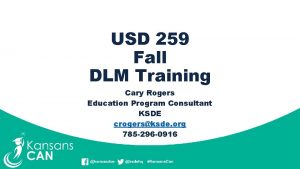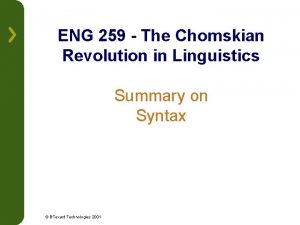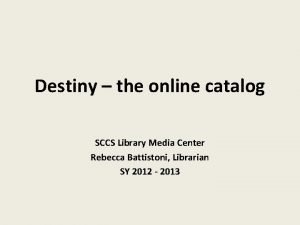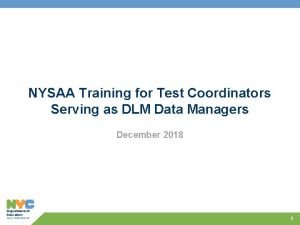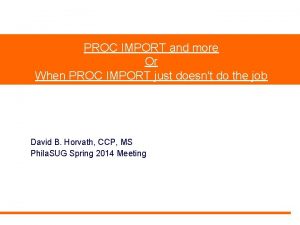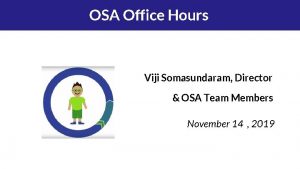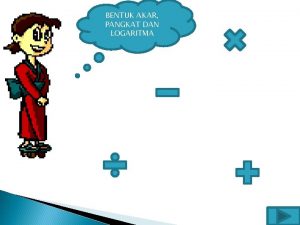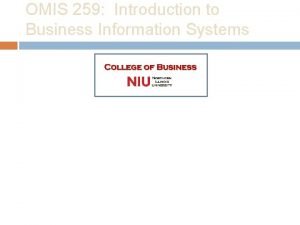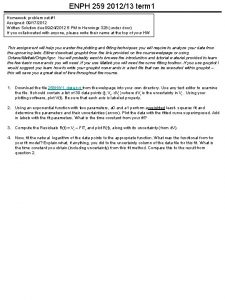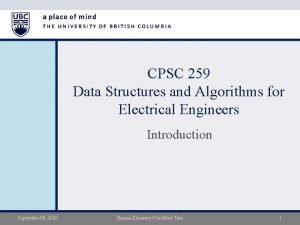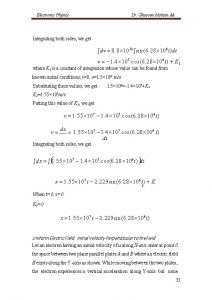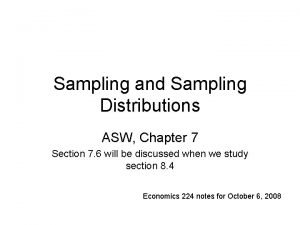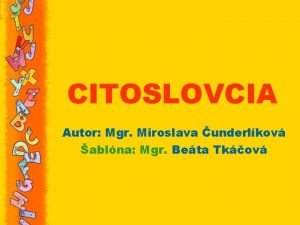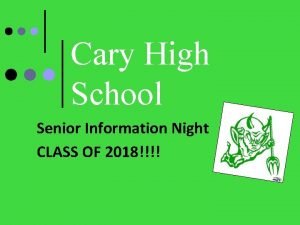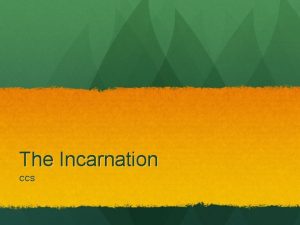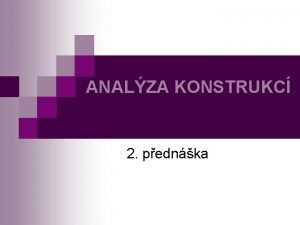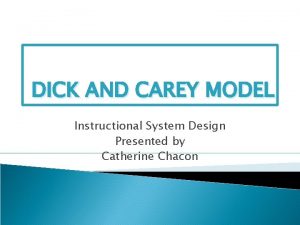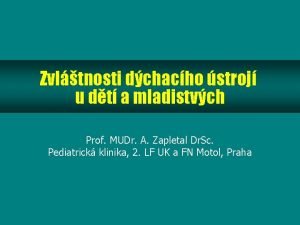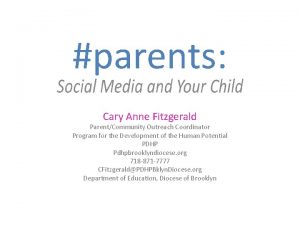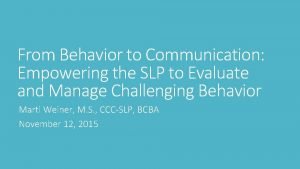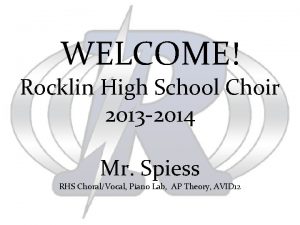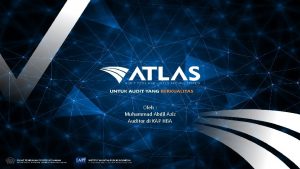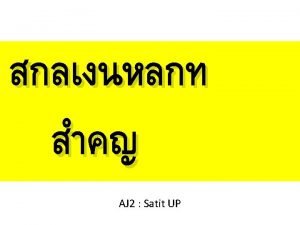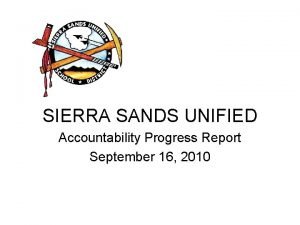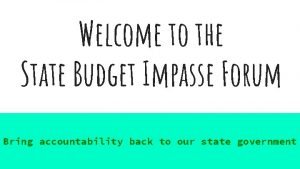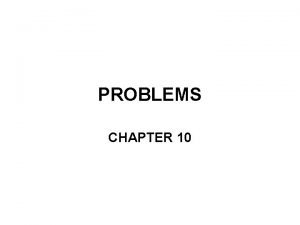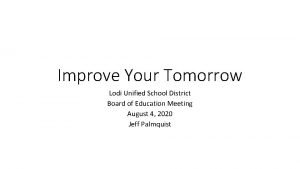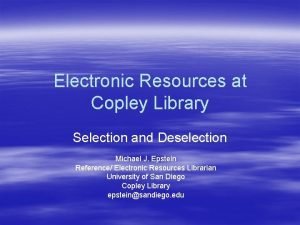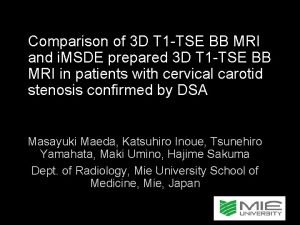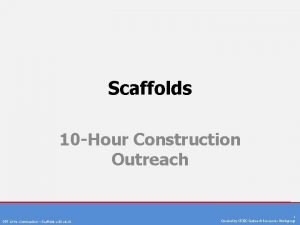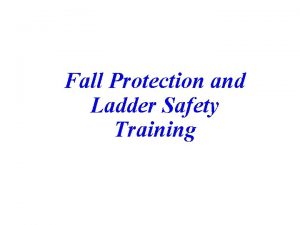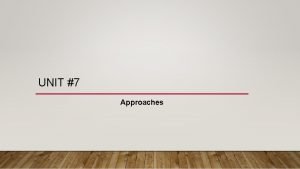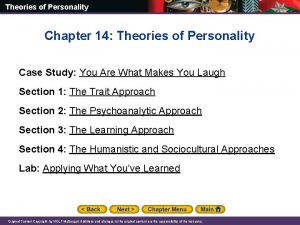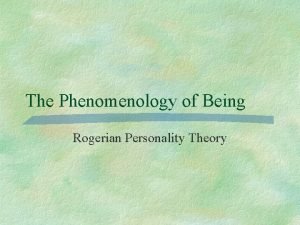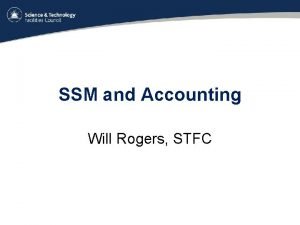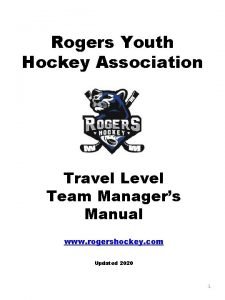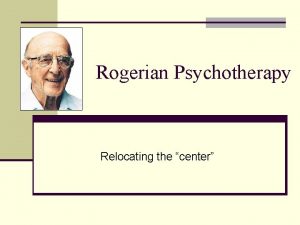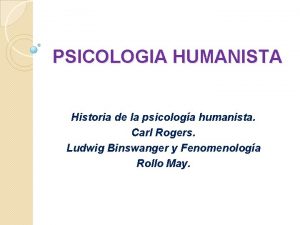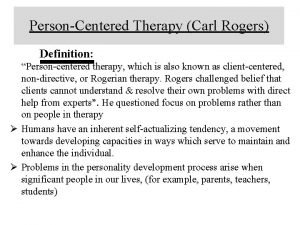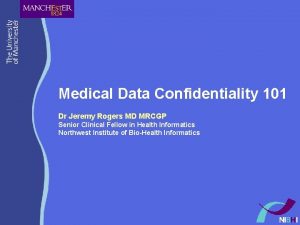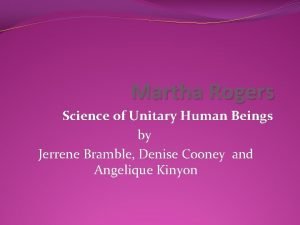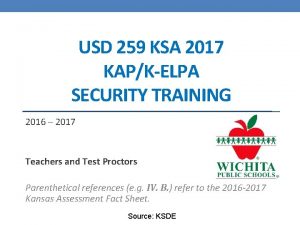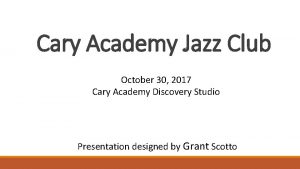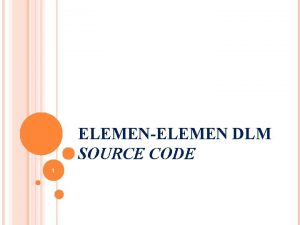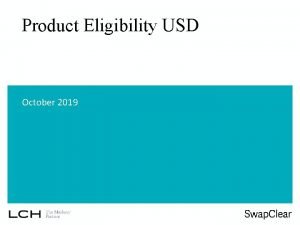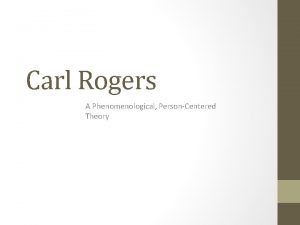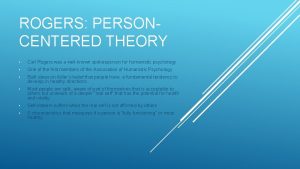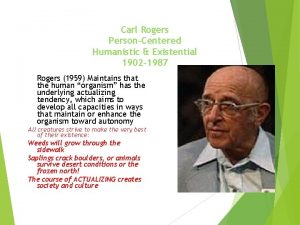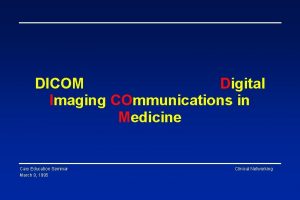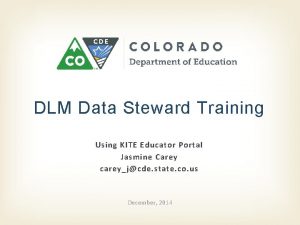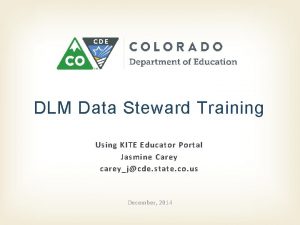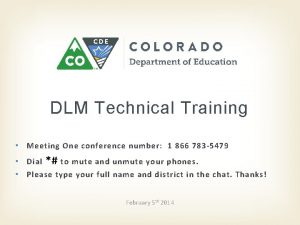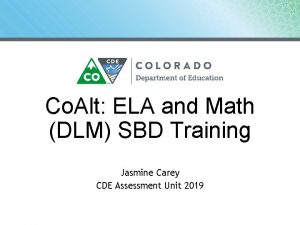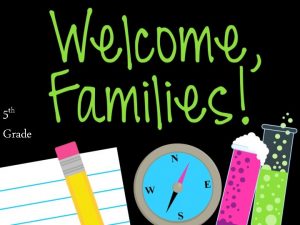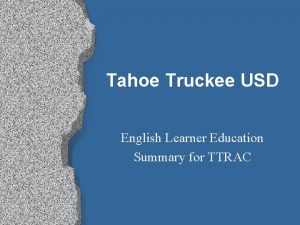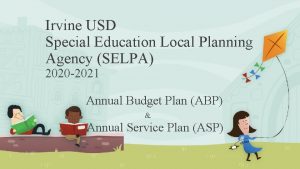USD 259 Fall DLM Training Cary Rogers Education




























































- Slides: 60

USD 259 Fall DLM Training Cary Rogers Education Program Consultant KSDE crogers@ksde. org 785 -296 -0916

Objectives: • Explain Least Dangerous Assumption and the role it plays in decision making. • Provide guidance for identifying students with a most significant cognitive disability. • Provide updates to DLM for the 2019 -2020 school year. • Show available resources to assist teachers with instruction with students with a most significant cognitive disability.

Agenda: • • • Least Dangerous Assumption -20 min Identifying students for the DLM – 25 min Changes for 2019 -2020 – 20 min Instructional resources- 40 min Questions – 15 min

Least Dangerous Assumption

Least Dangerous Assumption § Theory of Presuming Competence: Least Dangerous Assumption § “…in the absence of conclusive data, educational decisions ought to be based on assumptions which, if incorrect, will have the least dangerous effect on the likelihood that students will be able to function independently as adults. Furthermore, we should assume that poor performance is due to instructional inadequacy rather than to student deficits. ” § – Anne Donnellan, 1984 as quoted by Cheryl Jorgensen, 2005

Least Dangerous Assumption

KIM Scenario One Scenario Two Assumptions She isn’t smart, sub-average intelligence and ability to learn Treat her as smart, distrust validity of test results due to lack of communication and movement difficulties Educational setting Functional academics, speak in language more appropriate for younger child, functional skills, with other students with significant disabilities Variety of methods to teach her to read, talk to her like any other teenager, enrolled in general academic classes, natural opportunities to teach functional skills Communication support Vocabulary and supports correspond to assessment of intellectual disabilities Communication system includes words and concepts relating to current events, love, relationships, and her future Friendships and dreams Interactions with other students with disabilities, plan for moving into a group home and attend day program Encourage friendships, participate in activities with classmates, postsecondary education addressed Kansas leads the world in the success of each student.

Kim Scenario One Scenario Two Brain scan results IQ of 100 IQ of 40 Has any harm been done? Lost opportunity to teach her things she could have learned, missed social connections, missed high school experiences, low self-esteem, fewer possibilities for future career or post secondary education Most say nothing has been lost, her education program offered her opportunities to develop life-long interest, to make friends, to be part of the social life of the school, to be part of the community after graduation, learned and generalized functional skills within the natural context of the day. Modified from Cheryl Jorgensen article The Least Dangerous Assumption A Challenge to Create a New Paradigm

Least Dangerous assumptionpoints to ponder 1. Do all people have different talents and skills? 2. Is intelligence measured accurately and reliably enough to base students’ educational programs and future goals on test results? 3. Do Children learn best when they feel valued, when people hold high expectations for them, and when they are taught and supported well?

3 Principles of the least dangerous assumption If you are going to fail, fail because you believed in the student not because you placed an artificial limit on the student.

Dynamic Learning Maps (DLM)

Kansas Alternate Assessment Flow Chart The DLM is intended for students with the most significant cognitive disability in the state. Kansas leads the world in the success of each student.

Determination based on the student’s significant cognitive disability and not any of the following 1. A disability category or label 2. Poor attendance or extended absences 3. Native language/social/cultural or economic difference 4. Expected poor performance on the general education assessment 5. Academic and other services student receives 6. Educational environment or instructional setting 7. Percent of time receiving special education 8. English Language Learner (ELL) status 9. Low reading level/achievement level 10. Anticipated student’s disruptive behavior 11. Impact of student scores on accountability system 12. Administrator decision 13. Anticipated emotional duress 14. Need for accommodations (e. g. , assistive technology/AAC) to participate in assessment process

Review of the eligibility criteria 1. The student has a most significant cognitive disability – review of student records indicate a disability or multiple disabilities that significantly impact intellectual functioning (typically functioning 2 ½ - 3 standard deviations below the mean) Student must have a deficit in the student’s ability to plan, comprehend, and reason While a student with only a specific learning disability, speech impairment, or emotional disturbance may have significant academic challenges, he or she has the intellectual potential to reach gradelevel expectations. The description of specific learning disability, speech impairment, and emotional disturbance and the definition of significant cognitive disability present conflicting information.

Review of the eligibility criteria 2. The student has significant deficits in adaptive behavior – those skills and behaviors essential for someone to live independently and to function safely in daily life (typically functioning 2 ½-3 standard deviations below the mean) Limit a student’s ability to apply social and practical skills such as personal care, social problem-solving skills, dressing and eating, using money, and other functional skills across life domains It is unlikely to see these deficits in a student with a high incidence disability only, such as a specific learning disability, speech impairment, or emotional disturbance.

Review of the eligibility criteria 3. The student is primarily being instructed or taught using the DLM Essential Elements as content standards – goals and instruction listed in the IEP for this student are linked to the enrolled grade level DLM Essential Elements and address knowledge and skills that are appropriate and challenging for this student. Most likely requires teaching that includes hands-on materials, demonstrating concepts along with verbal directions, new tasks broken into small steps, prompting or shaping accurate performance, multiple opportunities and examples, and repeated student practice beyond disabled peers. Usually perform significantly below grade-level proficiency (an elementary student may perform 3 or more grade levels below age appropriate peers, while a high school student may perform 7 -9 grade levels below age appropriate peers.

Review of the eligibility criteria 4. The student requires extensive direct individualized instruction and substantial supports to achieve measurable gains in all gradeand age-appropriate curriculum. IEP goals are both functional and academic in nature Neither temporary nor limited to specific content areas Instruction appears very different from the instruction of their ageappropriate peers Requires daily individualized instruction in every academic area that is on a substantially different level of rigor than peers with disabilities Often requires an alternate curriculum, modified tasks, modified requirements, and frequent prompting that differs from his or her peers receiving special education services

Tammy – 10 th grade § Intellectual disability § Spends 75% of her day in general education classes § Reads above 3 rd grade level Sue – 8 th grade § Intellectual disability § Spends 80% of day in special education § Reads at 1 st grade level Ryan – 5 th grade § Traumatic Brain Injury § Spends 50% of day in general education room working on EE § Reads at 1 st grade level Joey – 3 rd grade § Autism § Spends majority of day in special education § Working on the general curriculum § Reads at 1 st-2 nd grade level

Dynamic learning maps - Resources § Updated DLM Participation Guidelines for Kansas § Kansas Alternate Assessment Flow Chart § Rubric for determining participation on the KAA (DLM) § DLM fact sheet § 2019 -2020 DLM testing schedule § 2019 -2020 DLM webinar schedule § Kansas DLM blueprint/record sheet § Essential Elements by Linkage Level Data § http: //www. ksde. org/Default. aspx? tabid=887 https: //dynamiclearningmaps. org/kansas

My student no longer meets eligibility requirements for the DLM § IEP or IEP amendment must be done to remove the alternate assessment § Contact your district test coordinator to remove the student from the DLM and add the student to the KAP § We ask teams to take care of this in the fall before administering any DLM testlets if possible. § If a student has to be exited after beginning the DLM, that is fine. We want the right students taking the right test.

My student qualifies for the DLM § Find out who your district test coordinator is. § Provide your district test coordinator with the name(s) of students who qualify for the DLM, the student(s) grade level, primary exceptionality, and the subjects your student will be taking in the DLM. (Note: students who take the DLM take it in all subject areas for that grade level. A student can not take a DLM in ELA and general assessment in math. § Let your district test coordinator know if you do not have an Kite Educator Portal account or if you are new to the DLM. You will not be able to complete the required training until this is done. § Your district test coordinator can get you access to Kite Educator Portal as a teacher for the DLM assessment. They will also be the individual to upload your students and roster files that link your students to you in each subject area.

Sign up for DLM test updates Subscribe to KAA listserv § https: //jfe. qualtrics. com/form/SV_6 Qcq 2 o 2 o. Gg. PCO 3 P Enter first name, last name, and email into form, then submit. § To sign up for KAA listserv, send this information: Subject line: KAA Listserv Body of message: Email address, First Name, Last Name, USD Number, USD Name, Work Phone Number Send to this address: crogers@ksde. org

Kite Educator Portal Enhancements for 2019 -2020

Educator Portal § Login to Educator Portal https: //educator. kiteaai. org § If this is your first time using Kite Educator Portal you will receive an email invitation from Kite-support@ku. edu after your assessment coordinator has added you. Click on the link in your email. You will be directed to set up a password. § Ensure that you can access “DLM” for Assessment Program and “teacher” for Role. § If you can’t access these, you need to contact your district test coordinator and request access to Educator Portal as a DLM teacher. You will not be able to complete your required training until this is done.

Sign your security agreement in Kite Educator Portal 1. Click on My Profile on the right hand side of the screen. 2. Click on Security Agreement 3. Select “I have read the security agreement and agree…” 4. Type your name in the box 5. Click “Save” Getting started in educator portal/signing security agreement video (4 min) https: //dynamiclearningmaps. org/district-staff-training-resourcesim#Getting. Started. In. EP There is up to a 3 hour wait time before you are able to log into Moodle for required training Kansas leads the world in the success of each student.

Required training § Training has been updated to reflect the changes on educator portal https: //training. dynamiclearningmaps. org/login/index. php § New test administrator training will take approximately 2 – 2 ½ hours (they have shortened this training) – 4 modules and quizzes § Returning test administrator training will take approximately 1 hour and 15 min. § Refer to the guide to required training on the DLM website https: //dynamiclearningmaps. org/sites/default/files/documents/Man uals_Blueprints/Guide_to_Required_Training_IE. pdf § Must pass quizzes with 80% accuracy § Login: Username will be your school email; Password is everything before the @sign on your email § Make sure to print your certificate – this is how moodle communicates with Educator Portal that the training is completed

Instruction and assessment planner Entering the Planner

Instruction and assessment planner Entering the Planner

First contact survey

Student view page • The student view page for each subject has two main sections: § Informational area § Blueprint • Informational Area -Includes directions, reminders, and links to student information § First Contact survey § PNP § Credentials

Student view page – informational area

Planner – student view page Blueprint Requirements -Blueprint view of student activity for the subject • • Grouped by requirement, and includes status for each requirement. Within each requirement, includes status for each Essential Element and linkage level.

Planner: student view page - Blueprint

Planner: Process § 1. Select an Essential Element Linkage Level card § 2. Select the Begin Instruction button

Planner: process (continued) § 3. Instruction for the Essential Element and linkage level is indicated as In Progress

Planner: process (continued) § 4. After instruction, select Instruction Complete Assign Testlet button

Planner: Process (continued) § 5. Testlet is assigned to student

Planner: Process (continued) § 6. Administer testlet to student § 7. Testlet marked as complete

Planner: process (continued) § As instruction is given and testlets are administered and tracked in the planner, the status for each requirement is updated.

Planner: other key features § Ability to print blueprint page § Themes (sensitive text) for English language arts only need to be selected one time for the student and can be updated as needed

Student Portal review and end page

Kansas Blueprint/Record Sheet Essential Element by Linkage Level

Kansas Blueprint/Record Sheet

Kansas Blueprint/Record Sheet

Essential Element by Linkage Level Data

Essential Element by Linkage Level Data

Accommodations

Accommodation for students on the general state assessment KAP § Kansas Assessment Program Tools and Accommodations § PNP Planning Tool for the KAP § Guidelines for Print Disabilities: The Consideration for Accommodations § Checklist for Text-to-Speech for ELA Passages

Print Disabilities and the consideration for accommodations A student with a print disability is unable to gain information from conventional printed materials at grade level, and needs alternate access to the information. • Students with blindness or visual impairments • Students with specific learning disabilities (dyslexia) • Students with physical disabilities Accessible Educational Materials and Assistive Technology • Required for all students with disabilities under IDEA • Helps eliminate the most frequent barriers that students with print disability encounter when accessing the general education curriculum and enable them to gain access to and progress in the general education curriculum located at http: //www. ksde. org/Default. aspx? tabid=553 and https: //ksdetasn. org/search/resources

Text-to-speech on the KAP state assessment Available for all students (UDL) ▪ Directions (ELA, math, science) ▪ All of the science assessment Available for students with IEP, 504, ILP, student improvement plan (must be selected on the students PNP) • Text only (questions and stems for ELA and math) • Text and graphics (all of the math assessment, questions and stems for ELA) • Nonvisual (for individuals with a print disability – must be approved by KSDE – TTS for ELA passages

Resources https: //www. dlmpd. com/instructional-resources/

Texts Resources https: //www. dlmpd. com/texts-resources/

Familiar Texts § Accessing DLM Familiar Texts https: //dynamiclearningmaps. org/erp_ie § Familiar texts used in DLM assessments are shared through Tar Heel Reader is a library of open-source, accessible, texts for individuals with disabilities of all ages. This page links directly to books used in DLM English language arts assessments. Find books by selecting Grade and Title. The link will take you to the book in Tar Heel Reader has been designed to allow students to use a variety of alternative access methods. More information about accessing Tar Heel Reader is available on its website. When you are on the title page of a book in Tar Heel Reader, you may click the settings icon at the top right of the screen to download Power. Point or EPUB versions of the books. § The links on this page go directly to books used in DLM assessments. Familiar texts are used at the Initial Precursor level and sometimes at the Distal and Proximal Precursor levels in grades 3– 5. These books have been developed using DLM text development guidelines adopted by DLM states; however, please note that Tar Heel Reader is a large, open-source library of books. Books are contributed to the site by teachers, students, parents, and others from all over the world. There are books on the site that are inappropriate for some audiences. Reviewers do their best to make sure these books are marked with the CAUTION. As a result, students should NOT be sent independently to the Tar Heel Reader site. Teachers can avoid books that they might find offensive by limiting their search to books that are “Reviewed Only” and “Rated E/Everybody. ”

Exemplar Text Supports § https: //www. dlmpd. com/exemplar-text-supports/ § One of the challenges in providing students with the most significant disabilities with access to the general curriculum is finding materials that link directly to the grade level content, but are written at a level that is accessible. As part of the DLM® project we have been building a library of companion texts that go with the exemplar texts called out in the Appendix of the Common Core State Standards. These books are accessible, open-source texts that you and your students can read online, on a reader that uses epub files, or offline as Powerpoint files or printed versions of the books.

Communication Supports https: //www. dlmpd. com/dlm-core-vocabulary-supports/

Writing Resources https: //www. dlmpd. com/writing-resources/

Initial and Distal Precursors https: //www. dlmpd. com/initial-and-distal-precursors/

Science Resources https: //dynamiclearningmaps. org/sci_resources

Professional Development https: //www. dlmpd. com/all-modules-organized-by-claim/

Cary Rogers, Education Program Consultant Kansas State Department of Education 900 SW Jackson St. Suite 620 785 -296 -0916 crogers@ksde. org The Kansas State Department of Education does not discriminate on the basis of race, color, national origin, sex, disability, or age in its programs and activities and provides equal access to the Boy Scouts and other designated youth groups. The following person has been designated to handle inquiries regarding the nondiscrimination policies: KSDE General Counsel, Office of General Counsel, KSDE, Landon State Office Building, 900 S. W. Jackson, Suite 102, Topeka, KS 66612, (785) 296 -3204
 Usd 259 portal
Usd 259 portal Tg grammar
Tg grammar Follettdestiny.cng
Follettdestiny.cng Parentvue usd 259
Parentvue usd 259 Baids test
Baids test Proc import dlm
Proc import dlm Dlm moodle
Dlm moodle Nyatakan perpangkatan berikut dlm bentuk perkalian berulang
Nyatakan perpangkatan berikut dlm bentuk perkalian berulang Ename
Ename Omis 259
Omis 259 Homework 259
Homework 259 Prairielearn ubc
Prairielearn ubc Physics 259
Physics 259 Asw-259
Asw-259 Joel rifkin
Joel rifkin Pět minut v africe noty
Pět minut v africe noty Citoslovcia
Citoslovcia Cary high school website
Cary high school website Cary christian school death
Cary christian school death Cary duffy
Cary duffy Příčinkové čáry
Příčinkové čáry Dick carey
Dick carey Where they harness the swift reindeer
Where they harness the swift reindeer Poklep plic
Poklep plic Zúžená část oceánů (moří) se nazývá
Zúžená část oceánů (moří) se nazývá Homework app
Homework app Ebs ruble
Ebs ruble Usd 232
Usd 232 Schoology rocklin usd
Schoology rocklin usd 71 usd
71 usd Eeur usd
Eeur usd Usd 475
Usd 475 Sierra sands usd
Sierra sands usd Canton usd 66
Canton usd 66 S$2 000 to usd
S$2 000 to usd Nt$1 350 to usd
Nt$1 350 to usd 34$ to nis
34$ to nis Improve your tomorrow
Improve your tomorrow Icbkcnb
Icbkcnb Copley library usd
Copley library usd Bb stock tsx toronto
Bb stock tsx toronto Atlas copco revenue in usd
Atlas copco revenue in usd Who trains employees that work on scaffolds
Who trains employees that work on scaffolds Ladder outline
Ladder outline Th rogers dress code
Th rogers dress code Uva applied math
Uva applied math Carl rogers humanistic theory
Carl rogers humanistic theory Chapter 14 theories of personality worksheet answers
Chapter 14 theories of personality worksheet answers Lori carl
Lori carl Phenomenological theory of personality
Phenomenological theory of personality Kenny rogers the gambler meaning
Kenny rogers the gambler meaning Rogers ssm
Rogers ssm Rogers hockey association
Rogers hockey association Who is carl rogers
Who is carl rogers Martha rogers
Martha rogers Carl rogers quien es
Carl rogers quien es Ludwig binswanger teoria humanista
Ludwig binswanger teoria humanista Carl roger's theory
Carl roger's theory Rogers féle pedagógiai kommunikáció
Rogers féle pedagógiai kommunikáció Jeremy rogers md
Jeremy rogers md Martha roger theory
Martha roger theory
